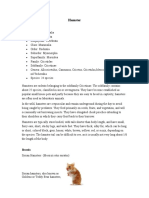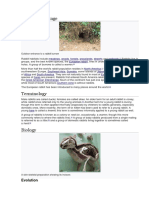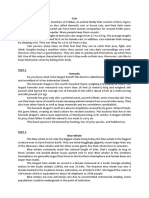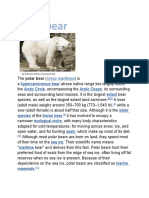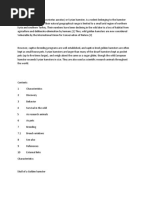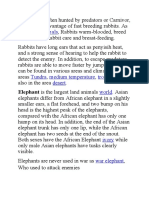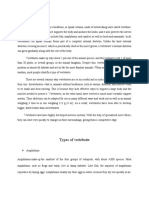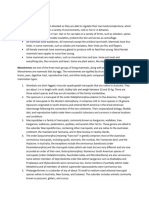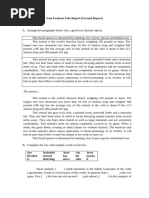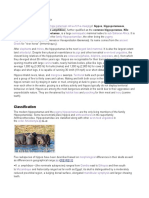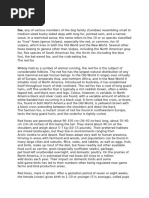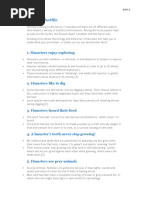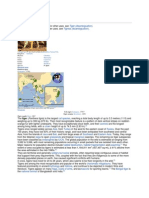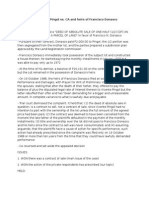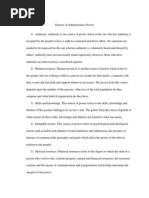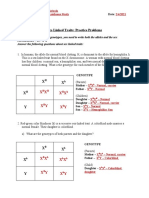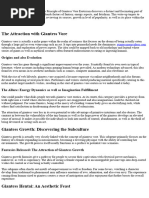100%(2)100% found this document useful (2 votes)
61 viewsHamsters Are: Phodopus Cricetulus
Hamsters Are: Phodopus Cricetulus
Uploaded by
Carey AntipuestoHamsters are rodents belonging to the subfamily Cricetinae. They live in burrows and are crepuscular, feeding on seeds, fruits and vegetation. They have cheek pouches for carrying food. Hamsters can be kept as pets and are commonly used as laboratory animals.
Copyright:
© All Rights Reserved
Available Formats
Download as DOCX, PDF, TXT or read online from Scribd
Hamsters Are: Phodopus Cricetulus
Hamsters Are: Phodopus Cricetulus
Uploaded by
Carey Antipuesto100%(2)100% found this document useful (2 votes)
61 views4 pagesHamsters are rodents belonging to the subfamily Cricetinae. They live in burrows and are crepuscular, feeding on seeds, fruits and vegetation. They have cheek pouches for carrying food. Hamsters can be kept as pets and are commonly used as laboratory animals.
Original Description:
some facts about hamsters
Original Title
Hamsters
Copyright
© © All Rights Reserved
Available Formats
DOCX, PDF, TXT or read online from Scribd
Share this document
Did you find this document useful?
Is this content inappropriate?
Hamsters are rodents belonging to the subfamily Cricetinae. They live in burrows and are crepuscular, feeding on seeds, fruits and vegetation. They have cheek pouches for carrying food. Hamsters can be kept as pets and are commonly used as laboratory animals.
Copyright:
© All Rights Reserved
Available Formats
Download as DOCX, PDF, TXT or read online from Scribd
Download as docx, pdf, or txt
100%(2)100% found this document useful (2 votes)
61 views4 pagesHamsters Are: Phodopus Cricetulus
Hamsters Are: Phodopus Cricetulus
Uploaded by
Carey AntipuestoHamsters are rodents belonging to the subfamily Cricetinae. They live in burrows and are crepuscular, feeding on seeds, fruits and vegetation. They have cheek pouches for carrying food. Hamsters can be kept as pets and are commonly used as laboratory animals.
Copyright:
© All Rights Reserved
Available Formats
Download as DOCX, PDF, TXT or read online from Scribd
Download as docx, pdf, or txt
You are on page 1of 4
Hamsters are rodents belonging to the subfamily Cricetinae.
The subfamily contains about 25 species,
classified in six or seven genera.
[1]
Hamsters are crepuscular and remain underground during the day to avoid being caught by predators.
In the wild, they feed primarily on seeds, fruits, and vegetation, and will occasionally eat
burrowing insects.
[2]
They have elongated cheek pouches extending to their shoulders in which they
carry food back to their burrows.
Hamster behavior varies depending on their environment, genetics, and interaction with people.
Because they are easy to breed in captivity, hamsters are often used as laboratory animals. Hamsters
have also become established as popular small house pets,
[3]
and are sometimes accepted even in areas
where other rodents are disliked, and their typically solitary nature can reduce the risk of excessive
litters developing in households.
Description[edit source | editbeta]
Roborovski hamster
Hamsters are typically stout-bodied, with tails shorter than body length, and have small, furry ears,
short, stocky legs, and wide feet. They have thick, silky fur, which can be long or short, colored black,
grey, honey, white, brown, yellow, red, or a mix, depending on the species. Two species of hamster
belonging to the genus Phodopus, Campbell's dwarf hamster (P. campbelli) and the Djungarian
hamster (P. sungorus), and two of the genus Cricetulus, the Chinese striped hamster (C. barabensis) and
the Chinese hamster (C. griseus) have a dark stripe down their heads to their tails. The species of
genus Phodopus are the smallest, with bodies 5.5 to 10.5 cm (2.2 to 4.1 in) long; the largest is
the European hamster (Cricetus cricetus), measuring up to 34 cm (13.4 in) long, not including a short tail
of up to 6 cm (2.4 in). The Angora hamster, also known as the long-haired or teddy bear hamster, which
is a type of the golden hamster is the second-largest hamster breed, measuring up to 18 cm (7.1 in)
long.
[3]
Skeleton of European hamster
Yawning white Syrian hamster showing large incisors
The hamster tail can be difficult to see, as it is usually not very long (about 1/6 the length of the body),
with the exception of the Chinese dwarf hamster, which has a tail the same length as the body. One
rodent characteristic that can be highly visible in hamsters is their sharp incisors; they have an upper
pair and lower pair which grow continuously throughout life, so must be regularly worn down. Hamsters
are very flexible, but their bones are somewhat fragile. They are extremely susceptible to rapid
temperature changes and drafts, as well as extreme heat or cold.
Senses[edit source | editbeta]
Hamsters have poor eyesight; they are nearsighted and colorblind.
[9]
[10]
To compensate for their poor
sight when in unfamiliar territory, hamsters have scent glands on their flanks (and abdomens in Chinese
and dwarf hamsters). A hamster rubs these areas of its body against various objects, and leaves a trail of
smells to follow to return to its home den.
[citation needed]
Hamsters also use their sense of smell to
identify pheromones and gender, and to locate food. They are also particularly sensitive to high-pitched
noises and can hear and communicate in the ultrasonic range.
[4]
Diet[edit source | editbeta]
Hamsters are omnivores. Although they can survive on a diet of exclusively commercial hamster food,
other items, such as vegetables, fruits, seeds, and nuts, can be given, but these should be removed
before they become rotten. Hamsters in the Middle East have been known to hunt in packs to find
insects for food.
[11]
Hamsters are hindgut fermenters and must eat their own feces (coprophagy) to
recover nutrients digested in the hindgut, but not absorbed.
[1]
Behavior[edit source | editbeta]
A behavioral characteristic of hamsters is food hoarding. They carry food in their spacious cheek
pouches to their underground storage chambers. When full, the cheeks can make their heads double, or
even triple in size.
[1]
Social behavior[edit source | editbeta]
Hamsters fighting
Most hamsters are strictly solitary. If housed together, acute and chronic stress may occur,
[5]
and they
may fight fiercely, sometimes fatally. Some dwarf hamster species may tolerateconspecifics. Russian
hamsters form close, monogamous bonds with their mates, and if separated, they may become very
depressed. This happens especially in males. Males will become inactive, eat more, and even show some
behavioral changes similar to some types of depression in humans.
[citation needed]
This can even cause
obesity in the hamster.
hodopus, a genus of rodents in the vole and hamster family Cricetidae, is a lineage of small hamsters
native to central Asia that display unusual adaptations to extreme temperatures. They are the only
known hamsters that live in groups and, in some cases, rely on significant contributions by males to the
raising of offspring. They are nocturnal and active throughout the year; they do not hibernate. Species
of Phodopus, together with members of the genera Cricetulus, Allocricetulus and Tscherskia are called
"dwarf hamsters" because of their small size (roughly 7 to 10 centimetres or 2.8 to 3.9 inches) relative to
other hamsters.
[2]
Like other hamsters, members of Phodopus have a round body shape, short tails and cheek pouches in
which they can store food. They all live in dry conditions with extreme temperatures. They inhabit the
forests, steppes and semi-deserts of Mongolia, Siberia, China and Kazakhstan. Fossils of Phodopus have
been found in Pleistocene and Pliocene deposits in Europe and Asia.
Phodopus species are commonly sold as pets.
[3]
They are also used as laboratory organisms for a variety
of studies, especially involving seasonal endocrine variation. Some species are considered to be
agricultural pests.
[4]
All three species are widespread and probably abundant, and are assessed as Least Concern (LC) by
the IUCN Red List.
[5][6][7]
However, their ecology and population dynamics are not well understood.
Historical records indicate they were once common in places where they no longer
occur.
[8]
Consequently, they are listed in the Kazakhstan Government Regulation of Approval of Rare and
Endangered Animal and Plant Species Index (2006).
[9]
Campbell's dwarf hamster[edit source | editbeta]
Main article: Campbell's dwarf hamster
Phodopus campbelli: The lips and cheeks have white fur, and the region around the ears is grey. A
dark dorsal stripe runs from the base of the neck to the base of the tail. The fur on the throat, abdomen
and legs is white, and the fur on top of the of the paws is silvery white. When the cheek pouches are full,
they extend back to the shoulders. The average body mass is 23.4 grams (0.8 oz).
[15]
Campbell's dwarf hamster (Phodopus campbelli) is a species of hamster in the genus Phodopus. It was
given its common name by Oldfield Thomas in honour of W.C. Campbell, who collected the first
specimen in Mongolia on July 1, 1902. It is distinguished from the closely related Djungarian hamster as
it has smaller ears and no dark fur on its crown. Campbell's dwarf hamster typically has a narrow dorsal
stripe compared to the Djungarian hamster and grey fur on the stomach.
In the wild, the breeding season for Campbell's dwarf hamster varies by location. For example, the
breeding season begins towards the middle of April in Tuva and towards the end of April in Mongolia.
However, in captivity, there is no fixed breeding season and they can breed frequently throughout the
year. Females are usually sexually mature at two months of age and the gestation period is typically 20
days. Campbell's dwarf hamster is crepuscular, along with all species of Phodopus and is active
throughout the year. Campbell's dwarf hamsters are omnivores, and so feed on both plant and insect
material. Campbell's dwarf hamster inhabits burrows with four to six horizontal and vertical tunnels in
the steppes and semi deserts of central Asia, the Altai mountains, autonomous areas of Tuva and
the Hebei province in northeastern China.
This hamster is listed as of Least Concern by the International Union for the Conservation of
Nature (IUCN). It is native to China, Kazakhstan, Mongolia and Russian Federation.
You might also like
- Rosacia V BulalacaoDocument2 pagesRosacia V BulalacaoCarey Antipuesto100% (1)
- Teen Titans: A Glance at Conflict and Gender StereotypesDocument6 pagesTeen Titans: A Glance at Conflict and Gender StereotypesElisabeth ChenNo ratings yet
- False CauseDocument12 pagesFalse CauseCarey Antipuesto0% (1)
- Holmes J. Paying Compliments - A Sex-Preferential Politeness Strategy (1988)Document21 pagesHolmes J. Paying Compliments - A Sex-Preferential Politeness Strategy (1988)Виктор Леонтьев100% (7)
- The Cinematic Art of NympholepsyDocument19 pagesThe Cinematic Art of NympholepsyMarija FilipovicNo ratings yet
- Exotic Final ProductDocument4 pagesExotic Final ProductSousuke YamazakiNo ratings yet
- Habitat and Range: EvolutionDocument3 pagesHabitat and Range: Evolutionoctavianc96No ratings yet
- Report Text PDFDocument2 pagesReport Text PDFGregorius Melvin ivander MartinsNo ratings yet
- Rabbit Habitats and HabitsDocument6 pagesRabbit Habitats and HabitsMonu Lal BurnwalNo ratings yet
- Company NameDocument10 pagesCompany NameRakesh DuttaNo ratings yet
- Animal Dictionary Vol. 2Document17 pagesAnimal Dictionary Vol. 2Imran KhanNo ratings yet
- Report TextDocument2 pagesReport Textfaridahafif97No ratings yet
- AnimalDocument22 pagesAnimalJudin BellNo ratings yet
- Hamsterul SirianDocument6 pagesHamsterul SirianIvanciuc AdrianNo ratings yet
- RabbitDocument13 pagesRabbitmcmusbixNo ratings yet
- Nama: Ilham Kurniawan Kelas: VIII3 PeacockDocument6 pagesNama: Ilham Kurniawan Kelas: VIII3 PeacockTreeLuckersNo ratings yet
- Black-Footed CatDocument6 pagesBlack-Footed CatSharmistha Talukder KhastagirNo ratings yet
- Rabbit Rabbits Are Small Mammals in The Family Leporidae of The OrderDocument11 pagesRabbit Rabbits Are Small Mammals in The Family Leporidae of The Orderramperough100% (1)
- Rabbit - WikipediaDocument16 pagesRabbit - WikipediaAmy KlezanNo ratings yet
- Species Used in The LaboratoryDocument12 pagesSpecies Used in The LaboratoryMoose KeNo ratings yet
- Jerboa: RodentDocument12 pagesJerboa: RodentAminudin Baki Bin MahmudNo ratings yet
- RenrenDocument11 pagesRenrenIrsih PeredaNo ratings yet
- Animales SalvajesDocument20 pagesAnimales SalvajesverovminiNo ratings yet
- Facts About Amur LeopardDocument8 pagesFacts About Amur LeopardCharumathi ChandraNo ratings yet
- RabbitsDocument5 pagesRabbitsdinberamboNo ratings yet
- Brown-Throated SlothDocument6 pagesBrown-Throated SlothSharmistha Talukder KhastagirNo ratings yet
- Descriptive Text About Animal 2Document5 pagesDescriptive Text About Animal 2Falisha Reyhana0% (1)
- FoxDocument3 pagesFoxAntonisNo ratings yet
- Report TextDocument22 pagesReport TextFiqri MuharamNo ratings yet
- Armadillo Meerkat NarwhalDocument16 pagesArmadillo Meerkat Narwhalganeshthangam.e3324No ratings yet
- Report Text About PandaDocument17 pagesReport Text About PandaAndre Andrian0% (1)
- Birds DictionaryDocument11 pagesBirds DictionaryImran Khan0% (1)
- Introduction On Elephant (Heading 2)Document4 pagesIntroduction On Elephant (Heading 2)Divya TaraNo ratings yet
- exotic_pets_in_our_lifeDocument35 pagesexotic_pets_in_our_lifeshaimaashaban59No ratings yet
- Science Holiday Home WorkDocument13 pagesScience Holiday Home WorkShalini RaniNo ratings yet
- ReportDocument13 pagesReportfuad101No ratings yet
- RATSDocument1 pageRATSFaiha Nasywa SuadahNo ratings yet
- Aardwolf: Jump To Navigation Jump To SearchDocument8 pagesAardwolf: Jump To Navigation Jump To SearchYeyen M. EvoraNo ratings yet
- Syrian HamsterDocument3 pagesSyrian HamsterAntonisNo ratings yet
- Project Work #2Document10 pagesProject Work #2230310035No ratings yet
- FY PracticalDocument10 pagesFY Practicallooperrr05No ratings yet
- Vertebrate and InvertebratesDocument9 pagesVertebrate and InvertebratesgwenethzNo ratings yet
- Sparrow - Wikipedia, The Free EncyclopediaDocument6 pagesSparrow - Wikipedia, The Free EncyclopediaAli XaiiNo ratings yet
- Monotremes Are One of The Three Main Groups of Living MammalsDocument2 pagesMonotremes Are One of The Three Main Groups of Living Mammalsfrederick menezaNo ratings yet
- CatDocument61 pagesCatYeah DudeNo ratings yet
- LATIHAN FACTUAL REPORTDocument6 pagesLATIHAN FACTUAL REPORTSerli ApriliantiNo ratings yet
- Mammalia LanjutanDocument28 pagesMammalia LanjutanRatih PurwaningrumNo ratings yet
- Report TextDocument14 pagesReport TextArif TirtaNo ratings yet
- SparrowDocument6 pagesSparrowOutofBeirutNo ratings yet
- Recount Animal Kelas 10Document5 pagesRecount Animal Kelas 10Febrian FadilahNo ratings yet
- Многообразие На Птиците - Copy en-USDocument15 pagesМногообразие На Птиците - Copy en-USNikolay KolevNo ratings yet
- "Swine" Redirects Here. For Other Uses, See Swine (Disambiguation)Document26 pages"Swine" Redirects Here. For Other Uses, See Swine (Disambiguation)ascui7434No ratings yet
- Hippo ResearchDocument6 pagesHippo ResearchkeithNo ratings yet
- Crows (: L. Cyclotis Respectively) - Elephants Are Scattered ThroughoutDocument7 pagesCrows (: L. Cyclotis Respectively) - Elephants Are Scattered ThroughoutAmitVyavahareNo ratings yet
- HummingbirdsDocument6 pagesHummingbirdsதுளசி இன்போஸ்No ratings yet
- Report TextDocument3 pagesReport TextRosyidahNo ratings yet
- Elephant Elephants Are Large Mammals of The Family: TerminologyDocument13 pagesElephant Elephants Are Large Mammals of The Family: TerminologyMukesh ManwaniNo ratings yet
- Report Text: Syahrul Nursapni G Xi - Ia 1Document4 pagesReport Text: Syahrul Nursapni G Xi - Ia 1Syahrul NursapniNo ratings yet
- FoxDocument3 pagesFoxkimocchineoNo ratings yet
- Hamster Factfile (PDF 48KB)Document2 pagesHamster Factfile (PDF 48KB)Camilo Ernesto Araujo BarabasNo ratings yet
- Descriptive Text Tentang Burung FlamingoDocument7 pagesDescriptive Text Tentang Burung FlamingoMuhamad RidwanNo ratings yet
- Habitat: World's Fastest AnimalsDocument2 pagesHabitat: World's Fastest AnimalsVasareNo ratings yet
- Tiger: This Article Is About The Feline. For Other Uses, See - "Tigress" Redirects Here. For Other Uses, SeeDocument6 pagesTiger: This Article Is About The Feline. For Other Uses, See - "Tigress" Redirects Here. For Other Uses, SeeSiddesh BhagatNo ratings yet
- Madrigal V LecarozDocument2 pagesMadrigal V LecarozCarey AntipuestoNo ratings yet
- Malayan Insurance V ReyesDocument2 pagesMalayan Insurance V ReyesCarey AntipuestoNo ratings yet
- Metropolitan Bank V CADocument3 pagesMetropolitan Bank V CACarey AntipuestoNo ratings yet
- Metro Inc V Lara's Gifts and DecorsDocument2 pagesMetro Inc V Lara's Gifts and DecorsCarey Antipuesto100% (1)
- 94 Spouses Pingol vs. CA and Heirs of Francisco DonascoDocument3 pages94 Spouses Pingol vs. CA and Heirs of Francisco DonascoCarey AntipuestoNo ratings yet
- City of Manila V Grecia-CuerdoDocument2 pagesCity of Manila V Grecia-CuerdoCarey AntipuestoNo ratings yet
- Dela Cruz Vs CA and Tan TeDocument3 pagesDela Cruz Vs CA and Tan TeCarey AntipuestoNo ratings yet
- Lorenzana Food Corporation V DariaDocument2 pagesLorenzana Food Corporation V DariaCarey AntipuestoNo ratings yet
- Male and Female OFWs by OccupationDocument2 pagesMale and Female OFWs by OccupationCarey AntipuestoNo ratings yet
- Junio V Atty GrupoDocument2 pagesJunio V Atty GrupoCarey AntipuestoNo ratings yet
- Spouses Azana V LumboDocument2 pagesSpouses Azana V LumboCarey AntipuestoNo ratings yet
- Conciseness: The Six Cs of Effective CommunicationDocument13 pagesConciseness: The Six Cs of Effective CommunicationCarey AntipuestoNo ratings yet
- Reyes V VitanDocument2 pagesReyes V VitanCarey AntipuestoNo ratings yet
- Director of Lands V AbabaDocument4 pagesDirector of Lands V AbabaCarey Antipuesto100% (1)
- Khan V SimbilloDocument2 pagesKhan V SimbilloCarey AntipuestoNo ratings yet
- PCGG v. SandiganbayanDocument3 pagesPCGG v. SandiganbayanCarey AntipuestoNo ratings yet
- Wicker v. ArcangelDocument3 pagesWicker v. ArcangelCarey AntipuestoNo ratings yet
- Villatuya V TabalingcosDocument4 pagesVillatuya V TabalingcosCarey AntipuestoNo ratings yet
- Sources of PowerDocument2 pagesSources of PowerCarey AntipuestoNo ratings yet
- Albert BanduraDocument5 pagesAlbert BanduraCarey AntipuestoNo ratings yet
- Asian SpicesDocument2 pagesAsian SpicesCarey AntipuestoNo ratings yet
- Transformational GrammarDocument5 pagesTransformational GrammarCarey AntipuestoNo ratings yet
- Typology of Interest GroupsDocument2 pagesTypology of Interest GroupsCarey Antipuesto100% (1)
- Ibsen WomenDocument9 pagesIbsen WomenKashaf RiazNo ratings yet
- ProgesteroneDocument8 pagesProgesteroneVioleta NitaNo ratings yet
- The Play of Eros: Paradoxes of Gender in English Pantomime: Peter HollandDocument10 pagesThe Play of Eros: Paradoxes of Gender in English Pantomime: Peter HollandRejċ Těděsco TřıččasNo ratings yet
- Body PositivityDocument2 pagesBody PositivityAakash VinodkumarNo ratings yet
- Social Legislation and Social PolicyDocument3 pagesSocial Legislation and Social PolicyTJ Julian Baltazar50% (2)
- Kariotipo AnalizėDocument5 pagesKariotipo Analizėpijus mickevičiusNo ratings yet
- (Homo) Eroticism and Calixthe Beyala, by Sybille Ngo Nyeck, On Witness Mag.Document5 pages(Homo) Eroticism and Calixthe Beyala, by Sybille Ngo Nyeck, On Witness Mag.IRNwebNo ratings yet
- Sex-Linked Traits: Practice Problems: X X X X X Y X YDocument3 pagesSex-Linked Traits: Practice Problems: X X X X X Y X YAlexandra HermosuraNo ratings yet
- Sex Education Prevents Teen PregnancyDocument2 pagesSex Education Prevents Teen PregnancyLeila Margrethe TrivilegioNo ratings yet
- Artificial Insemination: FIGURE 24. Procedure For Collecting Semen From A Gander (Source: Johnson, 1954)Document2 pagesArtificial Insemination: FIGURE 24. Procedure For Collecting Semen From A Gander (Source: Johnson, 1954)diagnoz7auto7carsvanNo ratings yet
- Fantasy and The Limits of EnjoymentDocument5 pagesFantasy and The Limits of Enjoymentblablabla8888No ratings yet
- Meiosis Picture Labels KEYDocument3 pagesMeiosis Picture Labels KEYWidjaya HS Teacher100% (1)
- Cunningham Revised 2015 ComplaintDocument8 pagesCunningham Revised 2015 ComplaintBeach ReporterNo ratings yet
- Factors Affecting Adoption of Agricultural TechnologiesDocument3 pagesFactors Affecting Adoption of Agricultural TechnologiesYaronBaba100% (1)
- Menstrual BloodDocument8 pagesMenstrual Bloodspanda09175No ratings yet
- Checklist ADocument1 pageChecklist ABarry BurijonNo ratings yet
- The Art of Janine Antoni - Labor, Gender and The Object of Performance PDFDocument429 pagesThe Art of Janine Antoni - Labor, Gender and The Object of Performance PDFJoão Paulo AndradeNo ratings yet
- VC CrimeDocument12 pagesVC CrimejhasouravNo ratings yet
- The Heterosexualized Eunuch in The RomanDocument10 pagesThe Heterosexualized Eunuch in The RomanXNo ratings yet
- UntitledDocument3 pagesUntitledapi-233604231No ratings yet
- Imasen vs. AlconDocument2 pagesImasen vs. AlconMonica FerilNo ratings yet
- MATH 213-Answer-Key-10541Document6 pagesMATH 213-Answer-Key-10541RR SosaNo ratings yet
- Ingesting Imagination: Examining The Concept of Giantess Vore Sexiness 150714Document2 pagesIngesting Imagination: Examining The Concept of Giantess Vore Sexiness 150714tosa.kab.akky99.3No ratings yet
- How God Makes BabiesDocument8 pagesHow God Makes BabiesBethany House Publishers67% (12)
- Sexual SelfDocument33 pagesSexual SelfZaralyn BernardoNo ratings yet
- SexEducation PDFDocument2 pagesSexEducation PDFrosieNo ratings yet
- Unit 4 Chapter 15Document91 pagesUnit 4 Chapter 15kikoNo ratings yet





